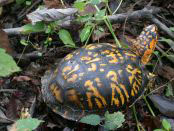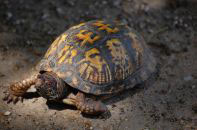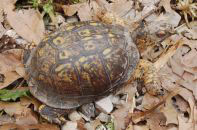Terrapene carolina (Linnaeus, 1758)



Key Characteristics: Keeled, high-domed carapace; hinged plastron lacking discrete pattern of light lines.
Similar Species: Ornate Box Turtle, Blanding’s Turtle. See Key to Adult Turtles of Illinois for help with identification.
Subspecies: Two subspecies are currently recognized, Eastern Box Turtle, T. c. carolina and Three-toed Box Turtle, T. c. triunguis (Agassiz, 1857). Although the Mississippi River has been the presumed barrier separating the two subspecies (carolina on the east side), specimens that are unquestionably tringuis (three toes and little patterning) have been found along the Illinois side of the Mississippi River. Smith (1961) considered the possibility that these may be waifs or represent intergradation between the two subspecies. Tucker & Hatcher (1994. Trans. Ill. State Acad. Sci. 87(3&4):201-206) reviewed the occurrence of triunguis specimens from western Illinois and proposed that the subspecies be added to the list of herpetofauna of Illinois.
Description: Small (up to 15 cm CL) turtle with highly variable carapace pattern of yellow or orange markings on dark background. Plastron tan or brown. Well-developed plastral hinge separates pectoral and abdominal scutes and allows shell to be closed completely. Male differs from female by having concave plastron and red rather than brown eyes. Carapace of hatchling round, brown, with pronounced keel and one yellow spot on each pleural and vertebral scute; plastron with dark central figure bordered by yellow.
Habitat: Forests and forest edges.
Natural History: Forages for berries, fungi, and a variety of invertebrates (earthworms, snails, slugs, insects). Two clutches of 3-8 ellipsoidal eggs (ca. 33 x 20 mm) are usually laid in June. Hibernates in late October or early November by burrowing into loose soil or pond bottom.
Status: Introduced by humans in urban areas throughout the state. Regularly seen in intact forests of southern half of state.
Etymology: Terrapene – (New Latin) from the Native American word for turtle; carolina – (New Latin) for Carolina.
Original Description: Linnaeus, C. 1758. Systema Naturae per Regina tri Naturae secundum Classes, Ordines, Genera, Species, cum Characteribus, Differentiis, Synonymis, Locis. 10th ed. Salvii, Stockholm. 1:824 pp.
Type Specimen: Not designated.
Type Locality: “Carolina”, restricted to vicinity of Charleston, South Carolina by Schmidt (1953).
Original Name: Testudo carolina Linnaeus, 1758
Nomenclatural History: Davis & Rice (1883. List of Batrachia and Reptilia of Illinois. Bulletin of the Chicago Academy of Sciences. vol. 1, no. 3) used the junior synonym Testudo clausa Gmelin, 1789. The generic names Cistuda and Cistudo have also been used.


